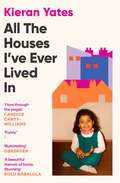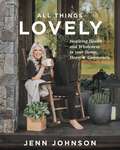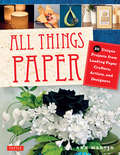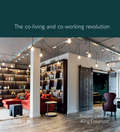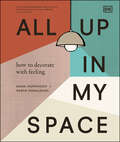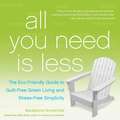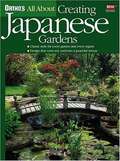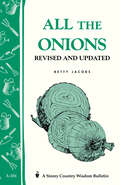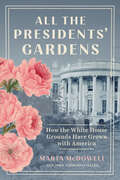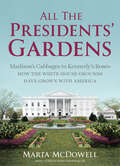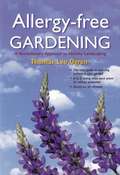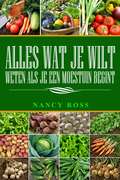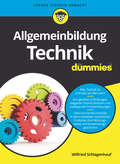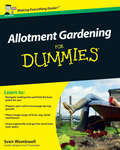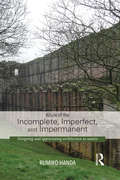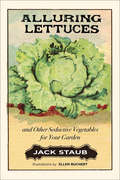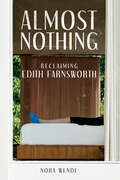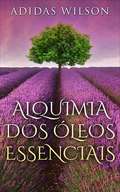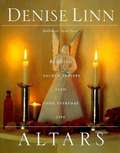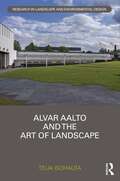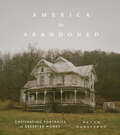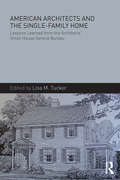- Table View
- List View
All The Houses I've Ever Lived In: Finding Home in a System that Fails Us
by Kieran Yates*PRE ORDER NOW*&‘I tore through the pages. A book I&’ll read over and over again&’ CANDICE CARTY-WILLIAMS&‘A beautiful exposition of home and what it means. Stunning&’ BOLU BABALOLA ____________________________________________By the age of twenty-five journalist Kieran Yates had lived in twenty different houses across the country, from council estates in London to car showrooms in rural Wales. And in that time, between a series of evictions, mouldy flats and bizarre house-share interviews, the reality of Britain&’s housing crisis grew more and more difficult to ignore.In prose that sparkles with humour and warmth, Yates charts the heartbreaks and joys of a life spent navigating the chaos of the housing system. She exposes the issues underpinning the crisis, from the state&’s neglect of social housing to the rental rat race, and the disproportionate toll these take on the most marginalised in society. Drawing on interviews with tenants across the country and the stories behind our interiors, she explores the unexpected ways we can fight back – finding beauty in the wreckage of a broken system, friendships in cramped housing conditions, and home even in the most fragile circumstances.All the Houses I&’ve Ever Lived In is at once a rallying cry for change and a love letter to home in all its forms. __________________________________________&‘So incisive it's hard to put down&’ PANDORA SYKES&‘Moving and urgent&’ LAURA BATES&‘Wholly transportive&’ CLARA AMFO&‘A powerful, personal and intricate tour of our housing system … exposing who it works for and who it doesn&’t&’ BELL RIBEIRO-ADDY MP
All The Onions: And How To Grow Them
by Betty JacobsDescribes how to grow, harvest, store, and use all the members of the onion family. Onions, garlic, shallots, leeks as well as others.
All Things Lovely: Inspiring Health and Wholeness in Your Home, Heart, and Community
by Jenn JohnsonTake the first steps to living as a healthier and happier woman and discover the spiritual importance of acceptance, gathering, and community. Jenn Johnson has come to realize that the pursuit of perfection is unrealistic and unfair. Instead, we need to pause and reflect on what's in front of us. But how? How can we slow down? How can we remain focused on what's important and do things with intention? What can we pursue that represents God's heart for us, things that are true, noble, right, pure, admirable, excellent, praiseworthy? By pursuing all things "lovely." Living a holistic and holy life, a life marked by beauty and truth, means being mindful and intentional about what we put in our bodies, how we present ourselves to the world, the spaces we create, and the people we let into our lives. When we set our minds on what is lovely, we begin to see ourselves and the world as God intended. We begin to be wholly renewed.
All Things Paper
by Ann MartinAnn Martin has searched the world over for unique and beautiful paper crafts to feature on her popular website--AllThingsPaper.net. In this book, she gathers completely new projects and shows how each is created, step-by-step.All of the paper products in this book are designed by respected paper craft artists, such as Benjamin John Coleman, Patricia Zapata, and Richela Fabian Morgan, who have been making amazing things with paper for many years. Each of the projects, from simple to more complex, has easy-to-follow instructions and detailed photos enabling you to create your own! These colorful and impressive pieces include art objects to display at home as well as items which have practical uses. All of the pieces make a wonderful keepsake or a gift that expresses the beauty, elegance, and versatility of paper.Projects include:Candle LuminariesCitrus Slice CoastersMysterious Stationery BoxEveryday Tote BagSilver Orb PendantFine Paper Yarn NecklaceWedding Cake CardPerfect Journey Journal
All Together Now: The co-working and co-living revolution
by Naomi Cleaver Amy FrearsonCollaborative spaces have been hailed as either the solution to the 21st century’s culture of overwork and broken housing market, or as an unworkable and impractical aspiration. Designing for such spaces has its particular challenges and considerations, especially in how to deliver attractive, healthy and efficient collaborative places. A practical and inspirational design guide, this book draws on the author's own experience, as well as the work of others, offering workable and practical solutions, and showcases a huge variety of different kinds of collaborative spaces across the globe. Including detailed and illustrated case studies across the co-living, co-working typologies – both new build and conversion, at different scales and in different settings – it concludes with a best practice toolkit, giving practical advice and lessons for all designers working at any scale. Case studies include: *The Project, Hoxton, London *Outpost, Bali *Venn, Tel Aviv
All Up In My Space: Discover Your Own Interior Design Style
by Emma Hopkinson Robyn DonaldsonYou have just gotten the keys, unpacked the boxes, and officially moved into your new apartment. Or maybe you have lived in your home for a couple years and it is in need of some extra love and care to make it into the place you always dreamt it would be. But where do you start? Should you repaint the walls or replace the floors? Are you a minimalist or a maximalist? What is missing?In this beautiful book, from the authors and creators of the award-winning blog All Up In My Space, Robyn Donaldson and Emma Hopkinson share their abundance of knowledge on interior design to help you figure out how to make your space your own. Learn about how to decorate a rental property without losing your deposit, discover how to switch things up in your home without having to change everything, and identify what type of interior design style suits you.With practical tips for things like painting and vintage shopping and advice on where to purchase classy yet budget-conscious furniture, this book is perfect for all home lovers. Each chapter will take you on a tour, room by room, to reveal cheaper but fabulous ways of adding your own style and flair to your home. Should you add a splash of paint, or do you need to rearrange the furniture? This captivating and beautifully illustrated book will teach and show you exactly what home really should feel like.Whether you are an introvert or an extrovert, live in an apartment or a house, or are on a tight budget, this book will make the perfect gift for all and will provide you with all the tips and tricks you need to make your space truly Instagram-able.
All You Need Is Less
by Billee Sharp Madeleine SomervilleMost eco-friendly books start with terror-inducing lists of the carcinogenic chemicals you are liberally slathering all over every single surface in your house, painting most people as as unwitting eco-villains, happily Lysol-ing your way straight to hell.Well, readers can just relax and unpack the (plastic) bags - no guilt trips today!At this point I think we all know that cleaning with bleach is bad and pop cans should go into the recycling - we're beyond that, yes?All You Need is Less is about realistically adopting an eco-friendly lifestyle without either losing your mind from the soul-destroying guilt of using a plastic bag because you forgot your reusable ones in the trunk of your car (again), or becoming a preachy know-it all whom everyone loathes from the tips of her organically-shampooed hair to the toes of her naturally sourced recycled sandals. It's all gotten kind of complicated, hasn't it? These days you're not "green" enough unless you quit your day job and devote your entire life to attaining an entirely carbon neutral lifestyle or throw out all of your possessions and replace them with their new "green" alternatives. This whole eco-friendly thing seems to have devolved into a horrific cycle of guilt, shaming and one-upping, and as a result people are becoming exhausted and getting annoyed and, oh my god, we are living in a world where one of my grocery bags says "This reusable bag makes me better than you." It doesn't have to be this way. It is possible to take easy baby-steps towards a more earth-friendly lifestyle without stress, guilt, or judgy eco-shaming. Top eco blogger Madeleine Somerville is here with really original ideas on how to save money and the planet. Her ideas are even fun! Somerville has emerged as the voice of reason on urban homesteading that is stress-free, sanity-based and above all do-able.From the book:Stop Using Disgusting Dryer SheetsDo y'all know that most dryer sheets coat use animal fats to coat your clothes with that 'fresh' fragrance? Yeah. It's disgusting. Switch to wool dryer balls, they're simple to make (plus a fun craft project for kids) and they work like a hot damn.Use Jars Instead of Travel Mugs1. You can screw on the lid and literally throw a jar full o' coffee into your purse (no more balancing keys, coffee, files etc!) 2. It takes immense resources to manufacture and sell all those plastic/metal travel mugs which are often lost/forgottenYou have old food jars hanging around anyway, why not make use of them? If they break or get lost,at least they were used one more time before reaching their final destination. I always get lots of compliments on my coffee jar.
All You Need Is Less: The Eco-friendly Guide to Guilt-Free Green Living and Stress-Free Simplicity
by Madeleine SomervilleMost eco-friendly books start with terror-inducing lists of the carcinogenic chemicals you are liberally slathering all over every single surface in your house, painting most people as as unwitting eco-villains, happily Lysol-ing your way straight to hell. Well, readers can just relax and unpack the (plastic) bags - no guilt trips today! At this point I think we all know that cleaning with bleach is bad and pop cans should go into the recycling - we're beyond that, yes? All You Need is Less is about realistically adopting an eco-friendly lifestyle without either losing your mind from the soul-destroying guilt of using a plastic bag because you forgot your reusable ones in the trunk of your car (again), or becoming a preachy know-it all whom everyone loathes from the tips of her organically-shampooed hair to the toes of her naturally sourced recycled sandals. It's all gotten kind of complicated, hasn't it? These days you're not "green" enough unless you quit your day job and devote your entire life to attaining an entirely carbon neutral lifestyle or throw out all of your possessions and replace them with their new "green" alternatives. This whole eco-friendly thing seems to have devolved into a horrific cycle of guilt, shaming and one-upping, and as a result people are becoming exhausted and getting annoyed and, oh my god, we are living in a world where one of my grocery bags says "This reusable bag makes me better than you." It doesn't have to be this way. It is possible to take easy baby-steps towards a more earth-friendly lifestyle without stress, guilt, or judgy eco-shaming. Top eco blogger Madeleine Somerville is here with really original ideas on how to save money and the planet. Her ideas are even fun! Somerville has emerged as the voice of reason on urban homesteading that is stress-free, sanity-based and above all do-able. From the book: Stop Using Disgusting Dryer Sheets Do y'all know that most dryer sheets coat use animal fats to coat your clothes with that 'fresh' fragrance? Yeah. It's disgusting. Switch to wool dryer balls, they're simple to make (plus a fun craft project for kids) and they work like a hot damn. Use Jars Instead of Travel Mugs 1. You can screw on the lid and literally throw a jar full o' coffee into your purse (no more balancing keys, coffee, files etc!) 2. It takes immense resources to manufacture and sell all those plastic/metal travel mugs which are often lost/forgotten You have old food jars hanging around anyway, why not make use of them? If they break or get lost,at least they were used one more time before reaching their final destination. I always get lots of compliments on my coffee jar.
All about Creating Japanese Gardens
by Alvin HortonThese days, people crave gardens that fill the soul and comfort the body. Japanese gardening answers those yearnings. This book demonstrates how to: create a feeling of sanctuary; make tranquil spaces; and arrange plants and ornaments.
All the Onions: Storey's Country Wisdom Bulletin A-204 (A\storey Country Wisdom Bulletin Ser.)
by Betty E. JacobsSince 1973, Storey's Country Wisdom Bulletins have offered practical, hands-on instructions designed to help readers master dozens of country living skills quickly and easily. There are now more than 170 titles in this series, and their remarkable popularity reflects the common desire of country and city dwellers alike to cultivate personal independence in everyday life.
All the Presidents' Gardens: How the White House Grounds Have Grown with America
by Marta McDowellThis New York Times bestseller shares the rich history of the White House grounds, revealing how the story of the garden is also the story of America. The 18-acres surrounding the White House have been an unwitting witness to history—kings and queens have dined there, bills and treaties have been signed, and presidents have landed and retreated. Throughout it all, the grounds have remained not only beautiful, but also a powerful reflection of American trends. In All the Presidents' Gardens bestselling author Marta McDowell tells the untold history of the White House grounds with historical and contemporary photographs, vintage seeds catalogs, and rare glimpses into Presidential pastimes. History buffs will revel in the fascinating tidbits about Lincoln&’s goats, Ike's putting green, Jackie's iconic roses, Amy Carter's tree house, and Trump's controversial renovations. Gardeners will enjoy the information on the plants whose favor has come and gone over the years and the gardeners who have been responsible for it all. As one head gardener put it, &“What&’s great about the job is that our trees, our plants, our shrubs, know nothing about politics.&”
All the Presidents' Gardens: Madison's Cabbages to Kennedy's Roses—How the White House Grounds Have Grown with America
by Marta McDowellA New York Times Bestseller and AHS Book Award winnerThe 18-acres surrounding the White House have been an unwitting witness to history—kings and queens have dined there, bills and treaties have been signed, and presidents have landed and retreated. Throughout it all, the grounds have remained not only beautiful, but also a powerful reflection of American trends. In All the Presidents' Gardens bestselling author Marta McDowell tells the untold history of the White House Grounds with historical and contemporary photographs, vintage seeds catalogs, and rare glimpses into Presidential pastimes. History buffs will revel in the fascinating tidbits about Lincoln’s goats, Ike's putting green, Jackie's iconic roses, and Amy Carter's tree house. Gardeners will enjoy the information on the plants whose favor has come and gone over the years and the gardeners who have been responsible for it all.
Allergy-Free Gardening
by Thomas L. OgrenWith allergy problems reaching epidemic levels, horticulturist Tom Ogren set out to investigate the role that urban landscaping plays in this health crisis. What he discovered was startling: The vastly disproportionate cultivation of all-male plant varieties produces large amounts of intensely irritating airborne pollen. This extensively researched reference helps gardeners and landscapers make landscaping choices that can drastically reduce their exposure to harmful allergens.
Alles wat je wilt weten als je een moestuin begint
by Nancy Ross Dick StadaWIL JE LEREN HOE JE EEN GEWELDIGE MOESTUIN MOET OPZETTEN? Of je nou wilt leren wat de beste groentesoorten zijn of hoe je je groente het hele jaar door goed kunt bewaren, dit boek zal je daarbij helpen! Hier is alvast iets van wat je zult leren… HET JUISTE TUINGEREEDSCHAP EEN TUIN BIJ HUIS EEN VOLKSTUIN EEN STAPPENPLAN BIJ HET OPSTARTEN VAN EEN TUIN DE MEEST GESCHIKTE GROENTESOORTEN DE GROENTE HET HELE JAAR BEWAREN DE VOORDELEN VAN HET TUINIEREN EN NOG VEEL MEER! Hier is alvast een lijstje van de groentesoorten die je leert kennen: MAÏS SPERZIEBONEN TOMATEN DOPERWTEN PEPERS EN NOG VEEL MEER!
Allgemeinbildung Technik für Dummies (Für Dummies)
by Wilfried SchlagenhaufOb Smartphone, Auto oder Kühlschrank - unser Alltag spielt sich in einer technisch geprägten Welt ab. In diesem Buch begleitet Wilfried Schlagenhauf Sie durch die faszinierende Welt der technischen Kultur. Nach der Lektüre dieses Buches werden Sie über manches technische Phänomen besser Bescheid wissen, die zugrundeliegenden Konstruktions- und Funktionsprinzipien kennen und technische Lösungen als clevere Antworten auf menschliche Bedürfnisse verstehen. Und es wird Ihnen leichter fallen, technische Produkte auszuwählen, zu bewerten und Kaufentscheidungen zu treffen. Spezielles Vorwissen naturwissenschaftlicher oder mathematischer Art brauchen Sie dazu nicht, versprochen! Lassen Sie sich technik-begeistern!
Allotment Gardening For Dummies
by Sven WombwellAllotment Gardening For Dummies is a lively, hands-on guide to getting the most out of your allotment. Whether you're interested in eating fresh, saving money, getting exercise or enjoying wholesome family fun, this is the guide for you. The step-by-step advice takes you through all the stages in the process, from securing an allotment and preparing your plot, to choosing what to grow and enjoying the benefits of abundant fresh food and a sociable and healthy hobby. With over 50 handy line drawings, plus information on how to grow organic and advice on storing and cooking the food you grow, this guide really does have it all!Allotment Gardening For Dummies includes:Part 1: Getting to Grips with Allotment GardeningChapter 1: What Are Allotments All About?Chapter 2: Getting hold of an AllotmentChapter 3: Getting StartedPart 2: Preparing for Allotment SuccessChapter 4: Deciding What to Grow, WhenChapter 5: Preparing Your PlotChapter 6: Keeping Your Soil HealthyChapter 7: Keeping Your Plants HealthyChapter 8: Growing OrganicPart 3: Growing a Few of Your Favourite VegetablesChapter 9: Going UndergroundChapter 10: The StaplesChapter 11: Growing Leafy GreensChapter 12: Planting Peas, Beans and Other PodsChapter 13: Growing More Exotic VegPart 4: Extending Your Allotment RepetoireChapter 14: Growing Wholesome HerbsChapter 15: Growing Fruitful FruitChapter 16: Nurturing Flowers on an AllotmentPart 5: Getting the Most Out of Your AllotmentChapter 17: Involving Children Around the AllotmentChapter 18: Hobnobbing with Allotment SocietyChapter 19: Growing Giant VegPart 6: The Part of Tens ChapterChapter 20: Ten Common Accidents and How to Prevent ThemChapter 21: Ten Ways to Revive a Flagging Allotment
Allure of the Incomplete, Imperfect, and Impermanent: Designing and Appreciating Architecture as Nature
by Rumiko HandaArchitects have long operated based on the assumption that a building is 'complete' once construction has finished. Striving to create a perfect building, they wish for it to stay in its original state indefinitely, viewing any subsequent alterations as unintended effects or the results of degeneration. The ideal is for a piece of architecture to remain permanently perfect and complete. This contrasts sharply with reality where changes take place as people move in, requirements change, events happen, and building materials are subject to wear and tear. Rumiko Handa argues it is time to correct this imbalance. Using examples ranging from the Roman Coliseum to Japanese tea rooms, she draws attention to an area that is usually ignored: the allure of incomplete, imperfect and impermanent architecture. By focusing on what happens to buildings after they are ‘complete’, she shows that the ‘afterlife’ is in fact the very ‘life’ of a building. However, the book goes beyond theoretical debate. Addressing professionals as well as architecture students and educators, it persuades architects of the necessity to anticipate possible future changes and to incorporate these into their original designs.
Alluring Lettuces: And Other Seductive Vegetables for Your Garden
by Jack StaubA richly illustrated guide to unique and gorgeous vegetable varieties for your garden. Seventy-five unusual and eminently beautiful vegetables are profiled in this charming book by expert gardener and garden designer Jack Staub. Within these pages, you&’ll discover produce not likely found at the supermarket, including the Asparagus Bean, Chinese Rat Tail Radish, Green Zebra Tomato, and Turkish Orange Eggplant. Staub includes history, stories, and lore surrounding the plants, as well as instructions for growing them outdoors or indoors in containers. Whether you're an avid gardener or a dabbler, you'll love the flowery descriptions and original art showcasing these vegetables that are perfect for your garden.
Almost Nothing: Reclaiming Edith Farnsworth
by Nora WendlThe iconic Edith Farnsworth House is a singular glass home designed by Mies van der Rohe. But the oft-told history of the house overwrites Farnsworth’s role as Mies’s collaborator and antagonist while falsely portraying her as the architect’s angry ex-lover. Nora Wendl’s audacious work of creative nonfiction explodes the sex-and-real-estate myth surrounding the Edith Farnsworth House and its two central figures. An eminent physician and woman of letters, Farnsworth left a rich trove of correspondence, memoirs, and photographs that Wendl uses to reconstruct her voice. Farnsworth’s memories and experiences alternate with Wendl’s thoughts on topics like misogyny and professional ambition to fashion a lyrical examination of love, loneliness, beauty, and the search for the divine. Eloquent and confessional, Almost Nothing restores Edith Farnsworth to her place in architectural history and the masterpiece that bears her name.
Alquimia Dos Óleos Essenciais
by Adidas WilsonÓleos essenciais têm qualidade variável. Se você é um aromaterapeuta ou um consumidor, avaliar a qualidade dos óleos essenciais (EOs) não é fácil. Eles são originários de todo o mundo e empresas, ou fornecedores obtê-los de atacadistas ou agricultores cuja integridade e práticas aprenderam a confiar. O consumidor final não tem ideia e não pode avaliar essas práticas e relacionamentos.
Altars: Bringing Sacred Shrines into Your Everyday Life
by Denise LinnTFrom the book: he urge to create sacred spaces is so deep in the human psyche that we often create them unconsciously. A gathering of photos on a piano, an arrangement of personal objects on a desk or fireplace mantel, are perhaps outer manifestations of an inner desire to establish hallowed and holy spaces in our environment. Denise Linn, the internationally acclaimed author of Sacred Space, speaks directly to this primal longing for sacred places. In Altars, she demonstrates in photos and text how you can enrich your home or office by creating unique shrines for healing and contemplation. Beautifully illustrated and thoroughly practical, Altars shows how to Create personal altars for devotion, transitions in life, manifestation, and love Choose the optimum place to locate your home altar, according to the points of the compass and the ancient principles of feng shui Select altar objects that are particularly suited to your special needs Purify yourself and your altars with incense, prayers, drumming, and chanting Everyone who yearns to enter into the mysterious and wondrous realms, to infuse ordinary moments with sacred meaning, will find a great abundance of beauty, inspiration, and wisdom in this unique book. Renowned lecturer, author, and visionary Denise Linn has researched spiritual practices from cultures throughout the world for more than twenty-nine years. Calling upon this wealth of knowledge, she originated the unique and groundbreaking feng shui system Interior Alignment . Her synthesis of practical information and spirituality has had a deep impact on thousands of participants worldwide. She is also the author of nine books, including Sacred Legacies, The Secret Language of Signs, Quest, and the international bestseller Sacred Space. Includes appendices which explain the meanings (traditionally) of items frequently used on altars: stones, shells, flowers, herbs and more.
Alvar Aalto and The Art of Landscape (Routledge Research in Landscape and Environmental Design)
by Teija IsohautaAlvar Aalto and The Art of Landscape captures the essence of the Finnish architect’s landscape concept, emphasising culture and tradition, which characterised his approach to and understanding of architecture as part of the wider environment. From the forests of his youth to sights from his travels, Alvar Aalto (1898–1976) was influenced by outdoor landscapes. Throughout his career, he felt the need to shape the terrain and this became a signature of his architecture. Divided into five chapters, this book traces Aalto’s relationship with landscape, starting with an analysis of his definitions and descriptions of landscape language, which ranged from natural references and biological terms, to synonyms and comparisons. It includes beautifully illustrated case study projects from the 1950s and 1960s, discussing Aalto’s transformation of different landscapes through topography, terracing and tiers, ruins and natural elements, horizon outlines, landmarks, and the repetition of form. Featuring archival sketches, garden drawings, and plans, the book also contains Aalto’s text ‘Architecture in the Landscape of Central Finland’ from 1925 in the appendix. This book provides fascinating, untold insights into Aalto’s relationship with landscape and how this developed during his lifetime, for scholars, researchers, and students interested in architecture and landscape history, landscape art, and cultural studies.
America the Abandoned: Captivating Portraits of Deserted Homes
by Bryan SansiveroPeer into the mysterious world of abandoned homes across the United States with this fascinating photography book—a visual exploration of what makes up a life, and what we leave in our wake. Photographer Bryan Sansivero has been uncovering abandoned homes for more than a decade, traveling across the country to capture them on film before they crumble completely, never sure of what he might find. Sansivero documents the inhabitants&’ everyday living rooms, kitchens, and bedrooms just as he found them, showcasing their unique furniture, clothing, books, appliances, toys, artwork, and other personal items, which often appear as if the owners were just there a moment ago. The stories of the former tenants remain mostly unknown, but the images are haunting time capsules, and a reminder that everything we own is temporary, and eventually will be left behind or forgotten. There is an element of mystery and eeriness that this imagery evokes. In addition to those who are entranced by beautiful coffee table books, America the Abandoned will entice those who love horror films and books—from Stranger Things to The Shining.
American Architects and the Single-Family Home: Lessons Learned from the Architects' Small House Service Bureau
by Lisa M. TuckerAmerican Architects and the Single-Family Home explains how a small group of architects started the Architects’ Small House Service Bureau in 1919 and changed the course of twentieth-century residential design for the better. Concepts and principles they developed related to public spaces, private spaces, and service spaces for living; details about the books they published to promote good design; as well as new essays from contemporary practitioners will inspire your own designs. More than 200 black and white images.
American Barns
by Jan ArnettThe heart of every working farm and ranch, the barn is an icon of rural America. This book chronicles - and celebrates - all the main types, and looks at how these treasures of early American architecture developed. It explains how a wealth of immigrant construction methods and range of environments and climates resulted in a fascinating variety of barn styles in the United States, from the earliest rare Dutch examples to simpler English types and others in more surprising shapes (round or even polygonal) crafted by the Shakers in the 1800s. It highlights the most notable, famous and historic barns that the reader can visit, and features highlights the efforts of conservation groups to preserve America's barns and find innovative ways to repurpose these glorious old structures as homes and studios--and as living monuments of rural heritage.
